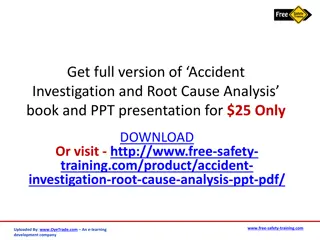
GAMS Sets and Data Assignment Examples
Learn about simple sets, multiple names for a set, aliasing sets, multi-dimensional sets, assigning data for higher dimensions, and working with tables in GAMS. Explore logical and numerical relationship operators for advanced modeling.
Download Presentation

Please find below an Image/Link to download the presentation.
The content on the website is provided AS IS for your information and personal use only. It may not be sold, licensed, or shared on other websites without obtaining consent from the author. If you encounter any issues during the download, it is possible that the publisher has removed the file from their server.
You are allowed to download the files provided on this website for personal or commercial use, subject to the condition that they are used lawfully. All files are the property of their respective owners.
The content on the website is provided AS IS for your information and personal use only. It may not be sold, licensed, or shared on other websites without obtaining consent from the author.
E N D
Presentation Transcript
Introduction to GAMS part II vikasargod@psu.edu Research Computing and Cyberinfrastructure
Sets Simple sets: S = {l,k,w} Set S /l,k,w/ It can also be written as: . Set S first three factors /l Labour index k Production index w welfare index /; Catch the error! set prices prices of fingerling fish/pound in 10 scenarios /P1*P10/
Multiple names for a set Let us consider the following example: Set c /c1,c2/ Parameter FoodPrices(c,c) c1 c2 c1 1 5 c2 5 1; Parameter cost(c,c); cost(c,c) = 2.5+10*FoodPrices(c,c); Display cost; What do you expect? Cost = 12.5 52.5 52.5 12.5 But answer will be Cost = 12.5 . . 12.5
Alias multiple names of a set Set c /c1,c2/ alias(c,cp); Parameter FoodPrices(c,c) c1 c2 c1 1 5 c2 5 1; Parameter cost(c,c); cost(c,cp) = 2.5+10*FoodPrices(c,cp); Display cost;
Multi-dimensional sets GAMS allows up to 10 dimensions set multidimset(set1name,set2name) /set1elementname.set2elementname /; e.g Sets Origins Destinations Demand points/Portland,London,Houston/ Originating Places /"New York", Boston/ Linkedbyroad(origins,destinations) / "NEW York" .Portland, "New York" .Houston, boston.Portland, boston.Houston/;
Assigning data for higher dimensions The elements in the n-tuple are separated by dots(.) Parameter Salaries(employee.manager.department) /anderson.murphy.toy 6000 hendry .smith .toy 9000 hoffman.morgan.cosmetics 8000/;
Tables with more dimensions Sets i /land,labor/ j /corn,wheat,cotton/ state /al,in/; Table avariant2(i,j,state) crop data al 1 6 1 4 1 8 in land.corn labor.corn land.wheat labor.wheat land.cotton labor.cotton 1 5 1 7 1 2;
Logical and numerical relationship operators lt, < le, <= eq, = ne, <> ge, >= not and or xor Strictly less than Less than-or-equal to Equal to Not equal to Greater than or equal to not and inclusive or exclusive or x = (1<2) + (2<3) x = 2 x = (1<2) or (2 <3) x = 1 x = (4 and 5) + (2*3 <=6) x = 2 x = (4 and 0) +)2*3 < 6) x = 0
The Dollar Condition $(condition) means such that condition is valid if ( cost > 100), then discount = 0.35 can be written as discount$(cost>100) = 0.35 Dollar logical conditions cannot contain variables Dollar condition can also be nested $(condition1$(condition2)) means $(condition1 and condition2)
Dollar on the left Consider rho(i)$(sig(i) ne 0) = (1./sig(i)) 1.; No assignment is made unless the logical condition is satisfied If the parameter on left hand side has not been initialized, then zero will be assigned The equation above can also be written as rho(i)$sig(i) = (1./sig(i)) 1.;
Dollar on the Right Consider labor = 2$(market > 1.5) An assignment is always made in this case If the logical condition is not satisfied, then the corresponding term will evaluates to 0 The expression above is equivalent to if(market > 1.5) then (labor = 2), else (labor = 0)
Dollar to filter assignments in a set Consider Variable shipped(i,j), total_cost; Equation costcalc; costcalc .. total_cost =e= sum((i,j)$newset(i,j), shipcost(i,j)*shipped(i,j));
Ord and Card Ord returns relative position in a one- dimensional and ordered set set t time periods /2001*2012/ parameter val(t); val(t) = ord(t); Card returns the number of elements in a set parameter s; s = card(t);
Control structures in GAMs If, Else, and Elseif If (logical condition, statements to be executed If true ; Elseif logical condition, statements executed If this conditional is true and the earlier one is false; else executed when all the previous conditionals were not satisfied;);
Control structures in GAMs If (key <= 0, data1(i) = -1 ; key2=case1; key2=case4; ) ; Elseif ((key > -1) and (key < 1)), data1(i) = data1(i)**2 ; key2=case2; Elseif ((key >= 1) and (key < 2)), data1(i) = data1(i)/2 ; key2=case3; else data1(i) = data1(i)**3 ;
Loop Loop((sets_to_vary), statement or statements to execute ); Syntax Loop (i, mainprice=priceindex(i); Solve marketmodel using lp maximizing optim; result(i)=optim.l; Example ) ;
While While(logical condition, statement or statements to execute ); Syntax While (converge = 0 and iter lt lim, root=(maxroot+minroot)/2; iter=iter+1; function_value=a-b*root+c*sqr(root); If(abs(function_value) lt tolerance, converge=1; else If(sign(function_value1)=sign(function_value), minroot=root; function_value1=function_value; else maxroot=root; function_value2=function_value; ); ); ); Example
For for (scalar_arg = start_val to(downto) end_val by increment, statements; ); Syntax for (iter = 1 to iterlimit, root=(maxroot+minroot)/2; function_value=a-b*root+c*sqr(root); If(abs(function_value) lt tolerance, iter=iterlim; else If(sign(function_value1)=sign(function_value), minroot=root; function_value1=function_value; else maxroot=root; function_value2=function_value;); ); ); Example
Repeat repeat ( statements to be executed; Syntax until logical condition is true ); repeat ( root=root+inc; function_value2= a-b*root+c*sqr(root); If((sign(function_value1) ne sign(function_value2) and abs(function_value1) gt 0 and abs(function_value2) gt tolerance), maxroot=root; signswitch=1 else If(abs(function_value2) gt tolerance, function_value1=function_value2; minroot=root;)); Example until (signswitch>0 or root > maxroot) ;);
Include External files $Include externalfilename The whole content of the files gets imported Include path of the file if it doesn t exist in current working directory If extension is not specified, .gms will be added automatically To suppress listing of include files $offinclude (in main gams file) $offlisting (in included file)
Writing to a file file factors /factors.dat/, results /results.dat/ ; put factors ; put Transportation Model Factors /// Freight cost , f, @1#6, Plant capacity /; loop(i, put @3, i.tl, @15, a(i)/); put / Market demand /; loop(j, put @3, j.tl, @15, b(j)/); put results; put Transportation Model Results // ; loop((i,j), put i.tl, @12, j.tl, @24, x.l(i,j):8:4 /); / Move cursor to first column of next line #n Move cursor position to row n of current page @n Move cursor position to column n of current line .ts Displays the text associated with any identifier .tl Displays the individual element labels of a set .te(index) Displays the text associated with an element of a set .tf Used to control the display of missing text for set elemnts
Writing to a file file factors /factors.dat/, results /results.dat/ ; put factors ; put Transportation Model Factors /// Freight cost , f, @1#6, Plant capacity /; loop(i, put @3, i.tl, @15, a(i)/); put / Market demand /; loop(j, put @3, j.tl, @15, b(j)/); put results; put Transportation Model Results // ; loop((i,j), put i.tl, @12, j.tl, @24, x.l(i,j):8:4 /);
Options Allows users to make run time overrides of a number of internal GAMS settings They can Control Solver Choice Add debugging output to the LST file Alter LST file contents Influence procedures used by solvers Change other GAMS settings Eliminate items from memory Form projections of data items
Options to control solver choice Option Basic Description LP Names LP solver MCP Names MCP solver MINLP Names MINLP solver MIP Names MIP solver NLP Names NLP solver RMINLP Names RMINLP solver RMIP Names RMIP solver example: option MIP=DICOPT
Options for influencing solver function Option Iterlim=number; Iterlim Maximum number of solver iterations. Absolute optimality tolerance in a MIP. The solver will stop the solution process when a solution is found whose objective value is guaranteed to be within optca of the best possible solution Option Optca = realnumber; (0.0 is the default) Optca Relative optimality tolerance in a MIP. The solver will stop the solution process when the proportional difference between the solution found and the best theoretical objective function is guaranteed to be smaller than optcr Option Optcr=realnumber; (0.10 is the default) Optcr Option Reslim=realnumber; (1000 is the default) Reslim Maximum seconds job can execute. Option Solprint=text; Text can beOn, Off, Silent Suppress solution printout in LST file. ( Silent suppresses all solution information) Solprint
MINLP in GAMS Default solver DICOPT Uses CPLEX (MIP solver) for integer part Other solvers available: SBB, BARON Option MINLP=solvername Set a good initial value variablename.l(set) = startingvalue; Zero is a bad initial value
Imposing priorities In MIP models users can specify an order for picking variables to branch on during a branch and bound search Priorities are set for individual variables through the use of the .prior variable attribute mymodel.prioropt = 1 ; z.prior(i,j) = 3 ; Closer to 1 higher the priority Higher the value of, lower the priority for branching
Model attributes for MIP solver performance modelname.cheat=x; Requires each new integer solution to be at least x better than the previous one Reduces number of nodes that the MIP solver examines Default is zero and it is an absolute value Setting a positive might cause some integer solution to miss Only for improving solver efficiency by limiting number of nodes
Model attributes for MIP solver performance modelname.cutoff=x; In branch and bound, the parts of the tree with an objective worse than the cutoff value x are ignored Speeds up initial phase of branch and bound algorithm Zero is the default and it is an absolute value Might miss true integer optimum if cutoff value is not set properly For maximization, worse means lower than the cutoff For minimization, worse means higher than the cutoff
Example problem ??? ???? ? ??????? ? ? ? ??????? ?? ????? ? ?? 10?? ?? 1000?? ?? is an integer variable for all s and ?? is a binary variable for all s More details are in simple_minlp.gms file
For Further reading McCarl GAMS User Guide http://www.gams.com/mccarl/mccarlhtml/index.html Example problem Copy simple_minlp.gms from /usr/global/seminar/econ/ cp /usr/global/seminar/econ/simple_minlp.gms . gvim simple_minlp.gms






















